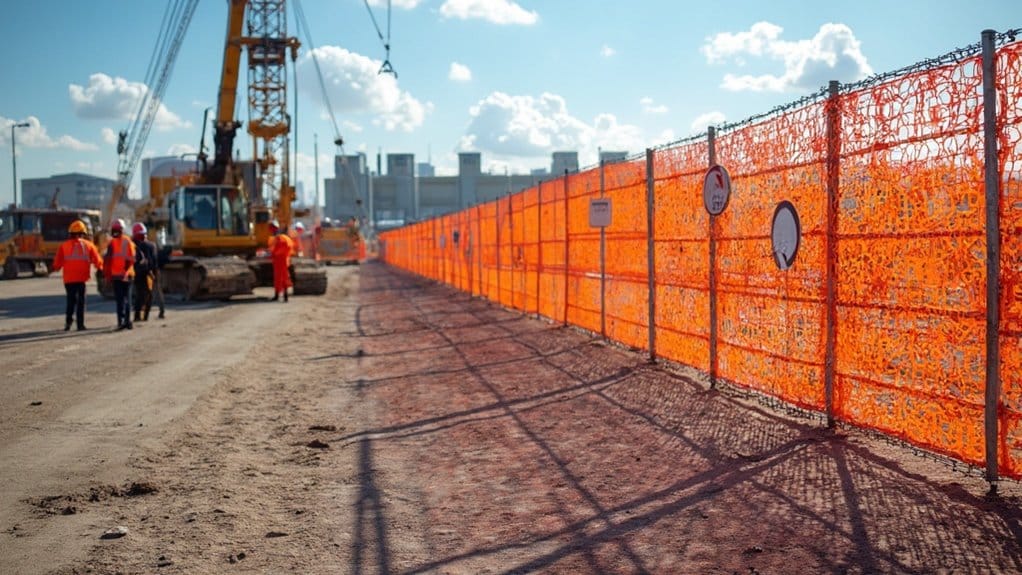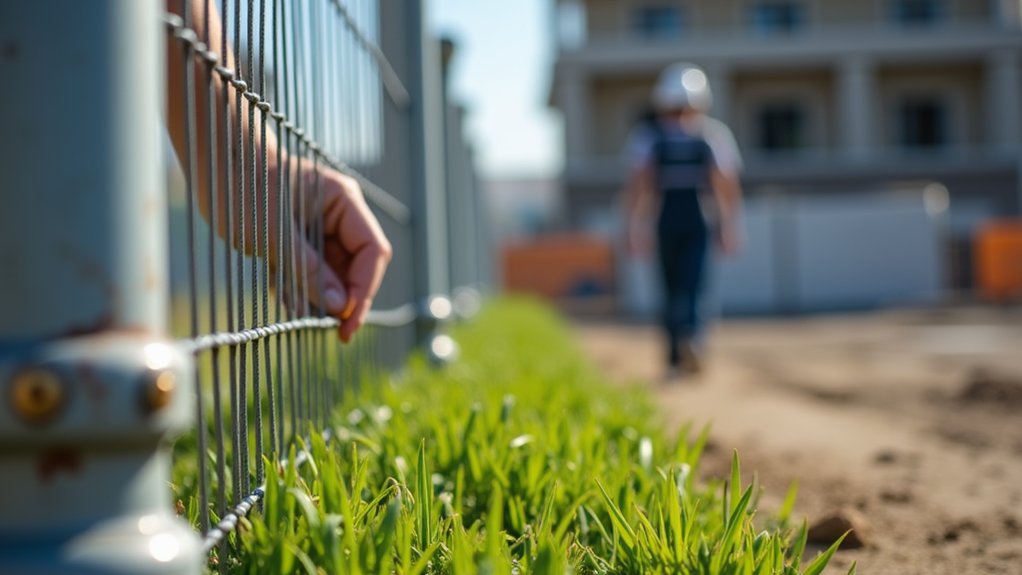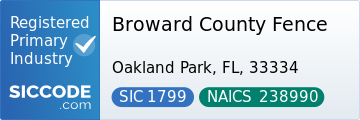For construction sites, effective temporary fencing options include chain link fencing for durability and security, and steel hoarding panels for privacy. Wire mesh fencing is a robust choice, while Heras fencing offers lightweight barriers that are easy to set up. Each option ensures compliance and safety by preventing unauthorized access. When choosing, consider your site conditions and installation requirements to find the best fit for your project.
Key Takeaways
- Chain Link Fencing is durable and low maintenance, perfect for marking site boundaries and providing security.
- Steel Hoarding Panels offer strong protection and can be customized, enhancing both safety and the look of the site.
- Wire Mesh Fencing is lightweight and quick to set up, effectively preventing unauthorized access and shielding against weather damage.
- Heras Fencing is modular and budget-friendly, great for perimeter security and managing crowds at construction sites.
- Plastic Barriers are an economical choice for temporary use, allowing for quick setup and easy relocation for short-term projects.
Overview of Temporary Fencing for Construction Sites
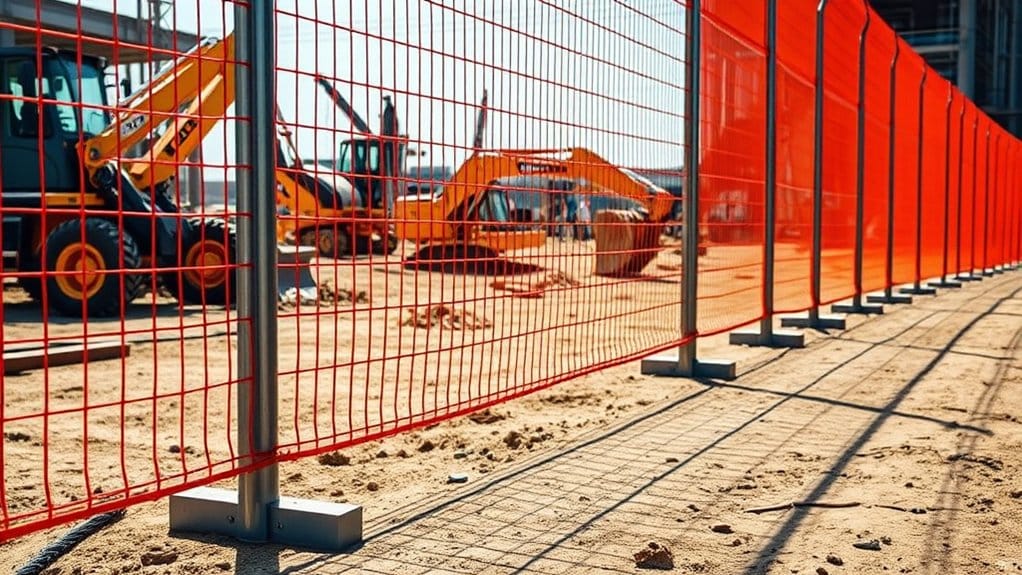
When managing a construction project, securing the site is crucial. Temporary fencing plays a key role in preventing unauthorized access and enhancing safety. It protects workers and equipment from potential hazards and helps you comply with local regulations. Additionally, it keeps the site organized and improves the neighborhood’s visual appeal by containing debris. For temporary fencing, proper installation is essential to ensure stability and effectiveness in safeguarding the site. For installation, consider portable panel fencing for its flexibility, ensuring it meets height and stability standards. The advantages of temporary fencing include cost-effectiveness and easy installation, making it a vital part of any construction site.
Chain Link Fencing: Durability and Security

Chain link fencing is a strong option for construction sites, thanks to its durability and security. Made from galvanized steel, it resists rust and can handle tough weather conditions, ensuring it lasts with little upkeep. This fencing also helps keep unauthorized people out, especially when combined with barbed wire or tension wire. Additionally, it provides clear boundaries that help keep unauthorized individuals out of designated areas. With its low maintenance demands, chain link fencing ensures that property owners can focus on their projects without worrying about upkeep.
| Feature | Benefits |
|---|---|
| Durability | Rust-resistant galvanized steel |
| Weather Resistance | Endures rain, wind, and heat |
| Security Enhancements | Barbed wire for extra protection |
| Easy Installation | Quick setup and takedown |
With its straightforward installation and flexibility, chain link fencing is a cost-effective and secure choice for your construction needs.
Steel Hoarding Panels: Privacy and Protection
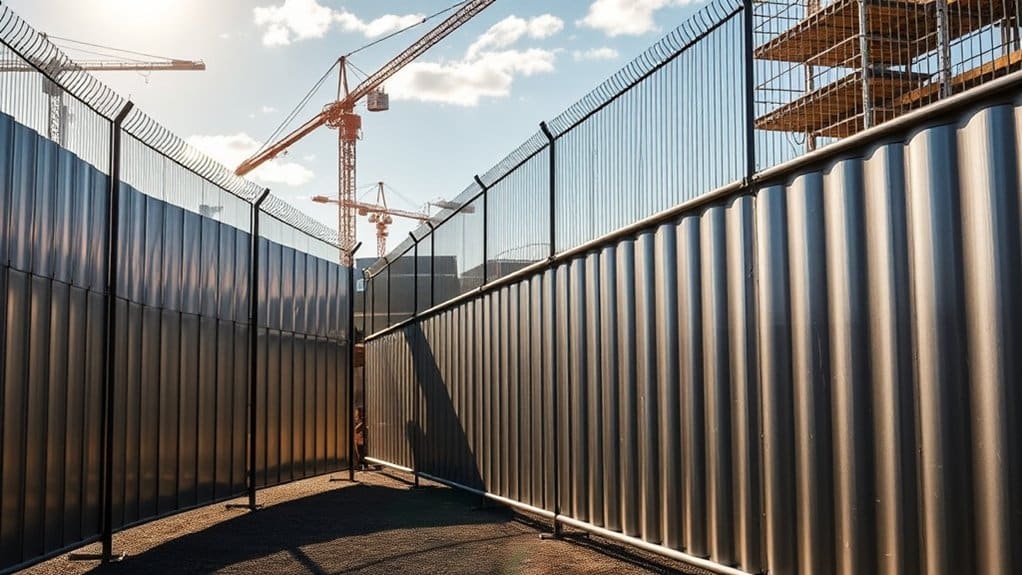
Steel hoarding panels are the perfect solution for construction sites needing privacy and protection. They can easily divide work areas while ensuring confidentiality.
Made from heavy-duty galvanized steel, these panels are durable and meet safety standards, reducing on-site hazards. They’re quick to set up and take down, requiring minimal labor, and can be reused for multiple projects, making them cost-effective. Additionally, they are available for hire and sale, providing flexibility for various needs.
You can customize them in different colors and sizes to match your brand or site needs. With strong frames and secure connections, these panels not only keep your site under wraps but also enhance workplace safety.
Wire Mesh Fencing: Heavy-Duty Solutions
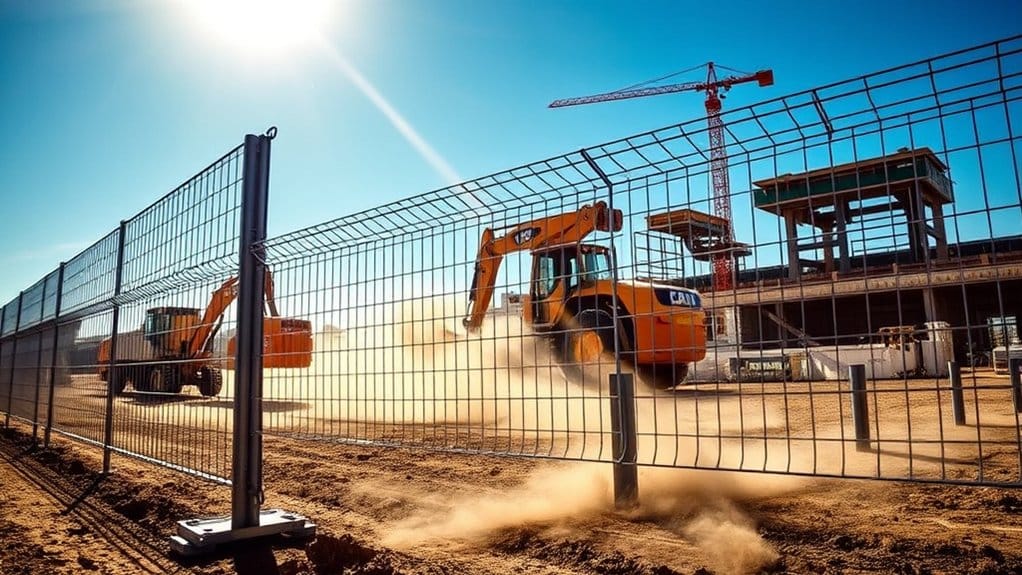
Wire mesh fencing is a solid choice for construction sites.
It’s tough enough to handle rough conditions and heavy use, making it reliable for safeguarding your area.
Installation is quick and easy, allowing you to set up a secure barrier in no time.
Plus, its lightweight design means you can move it around as needed without hassle.
Durability and Strength
When selecting temporary fencing for construction sites, wire mesh fencing stands out for its durability and strength. Made from high-quality steel with galvanized wires, it resists weather damage and rust effectively. The welded structure offers stability, making it strong against impacts.
| Feature | Benefits |
|---|---|
| Material Composition | Durable steel wires |
| Impact Resistance | Withstands wear and tear |
| Security Enhancement | Blocks unauthorized access |
Wire mesh fencing is a long-lasting choice that requires less maintenance compared to chain-link options. Its tensile strength and anti-climb design ensure your site remains secure and adaptable to evolving project needs.
Installation and Portability
Choosing wire mesh fencing for your construction site offers easy installation and portability.
Its modular design allows for quick assembly and disassembly, perfect for changing site conditions.
Consider these three key points:
- Installation Techniques: Make sure to prepare the site by leveling and marking for a secure setup.
- Portability Features: The free-standing design and minimal tools needed make it easy to relocate without hassle.
- Stability Measures: Use sandbags or weights to keep the fence stable against wind and other environmental factors.
Heras Fencing: Lightweight Barriers
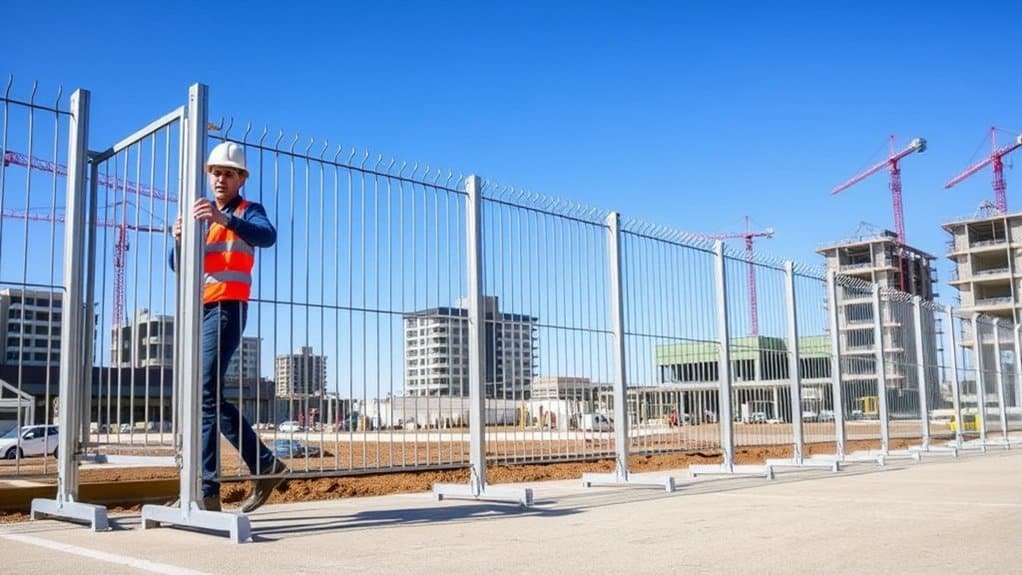
Heras fencing is a top choice for construction sites and events due to its lightweight yet sturdy design. Made from galvanized steel, each panel weighs about 17 kg and measures 3.5 meters by 2 meters, making them easy to transport.
The welded mesh offers great security, and the tubular frame adds strength without being cumbersome. Heras fencing features anti-climb options and a modular design for quick setup.
It’s commonly used for perimeter security on construction sites and crowd control at events. You can customize Heras fencing with options like anti-climb and city fences to fit your project’s specific needs, enhancing safety and accessibility.
Panel Fencing: Flexibility and Reconfiguration
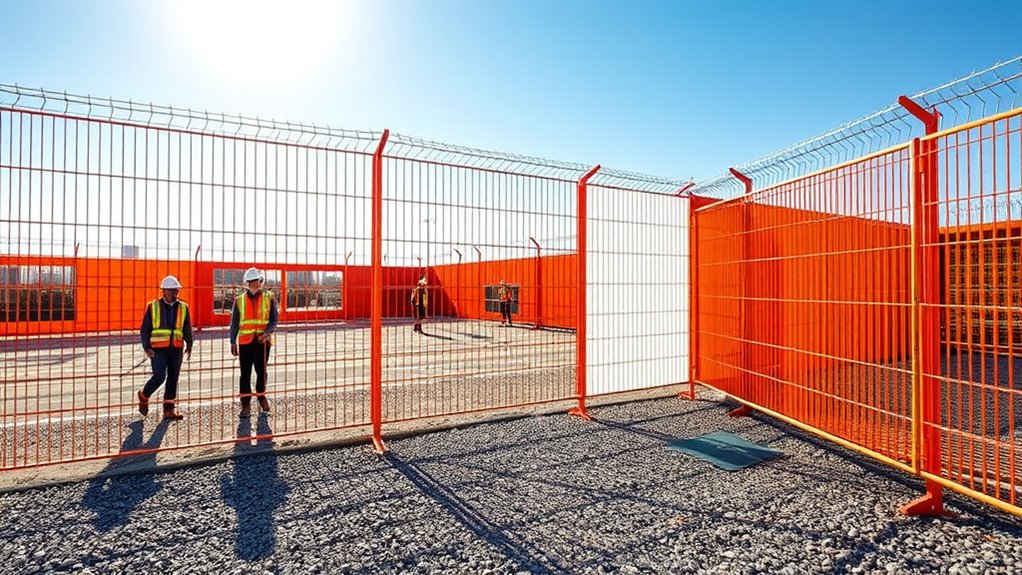
Panel fencing is a smart choice for your construction site.
It’s quick to set up, saving you both time and labor costs. The modular design makes it easy to adjust as your site layout changes.
If you need to relocate, panel fencing provides an affordable way to keep your project moving forward.
Easy Setup Process
Setting up temporary panel fencing for construction sites is quick and easy, boosting your project’s efficiency.
Here are three main benefits:
- Few Tools Needed: Most panels, like chain link and welded wire fences, require minimal tools for assembly, allowing for a fast setup.
- Flexible Layouts: Modular connections let you easily adjust the fence configuration as your project evolves.
- Pre-Marked Designs: These ensure quick alignment of panels, speeding up installation and enhancing stability.
Additionally, using no-dig fences can further simplify your setup, ensuring a sturdy and low-maintenance solution.
With these advantages, temporary panel fencing is a smart choice for your construction site.
Modular Design Benefits
Modular fencing is an excellent choice for construction sites that need to adapt quickly to changing conditions. Its design allows for easy disassembly and reassembly, so you can respond to project needs without hassle.
You can also customize the look of the fencing with different colors and textures to match your site’s aesthetic while maintaining a professional appearance. Made from durable materials, modular fencing stands up to tough environments and provides a secure barrier against unauthorized access.
Plus, you can adjust the height and swap out panels, making it a flexible option for any construction project. Choose modular fencing for efficiency and tailored solutions that meet your specific needs.
Cost-Effective Relocation Solutions
Cost-effective relocation solutions are crucial for efficient construction site management, particularly with panel fencing.
Here are three main benefits:
- Reusability: Panel fencing can be used at different sites, saving money in the long run.
- Quick Setup: Fast installation reduces labor costs and minimizes downtime, keeping your project on schedule.
- Transport Efficiency: Stackable panels lower transport costs, allowing for better budget allocation.
Advantages of Temporary Fencing in Construction
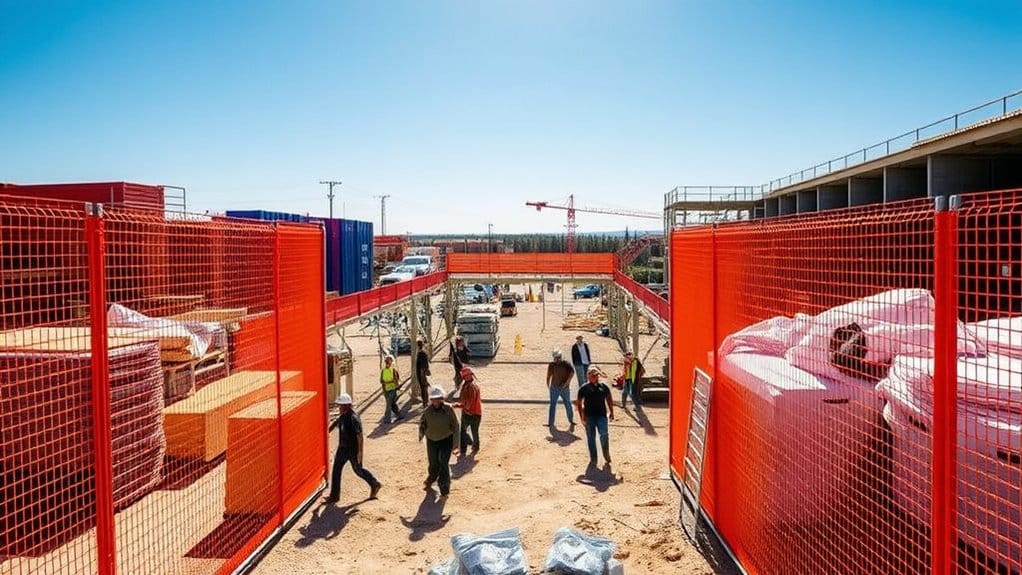
Temporary fencing is vital for construction site management, offering several key benefits.
Firstly, it enhances security by preventing unauthorized access and deterring theft and vandalism, protecting valuable tools and materials.
Additionally, it aids in crowd management by keeping the public safe from hazards like falling debris and open trenches. Temporary fencing clearly marks safe zones, restricts entry to dangerous areas, and helps maintain safe evacuation routes in emergencies.
Durability and Maintenance Considerations
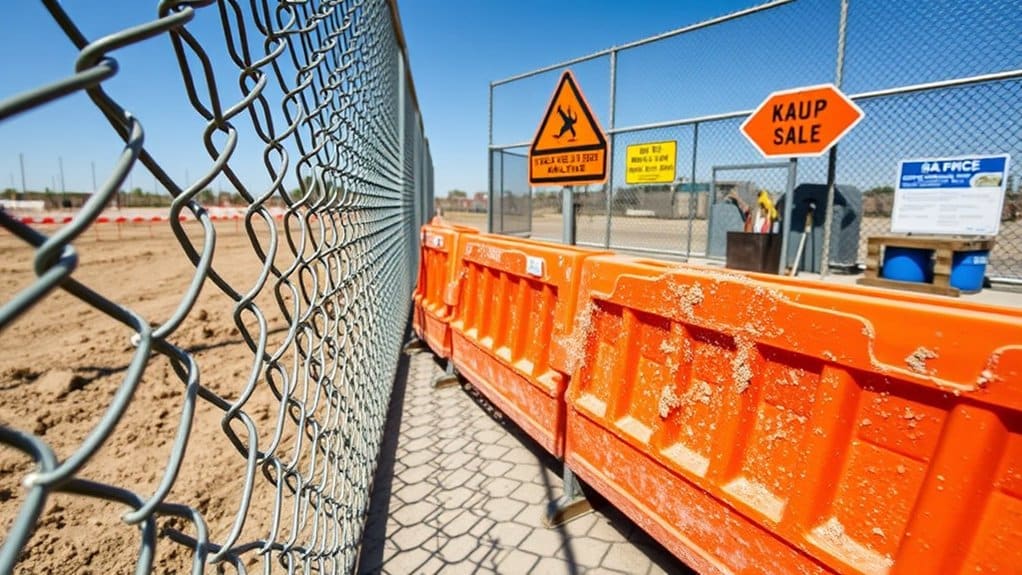
Understanding durability and maintenance for temporary fencing in construction is crucial. Here are some key points:
- Material Choice: Use galvanized steel or chain link; they resist rust and require less upkeep.
- Regular Checks: Inspect the fencing frequently to catch any damage early and extend its lifespan.
- Weather Considerations: Be aware of wind and moisture, as they can weaken the fencing. Secure it properly to ensure stability.
Cost-Effectiveness of Different Fencing Types
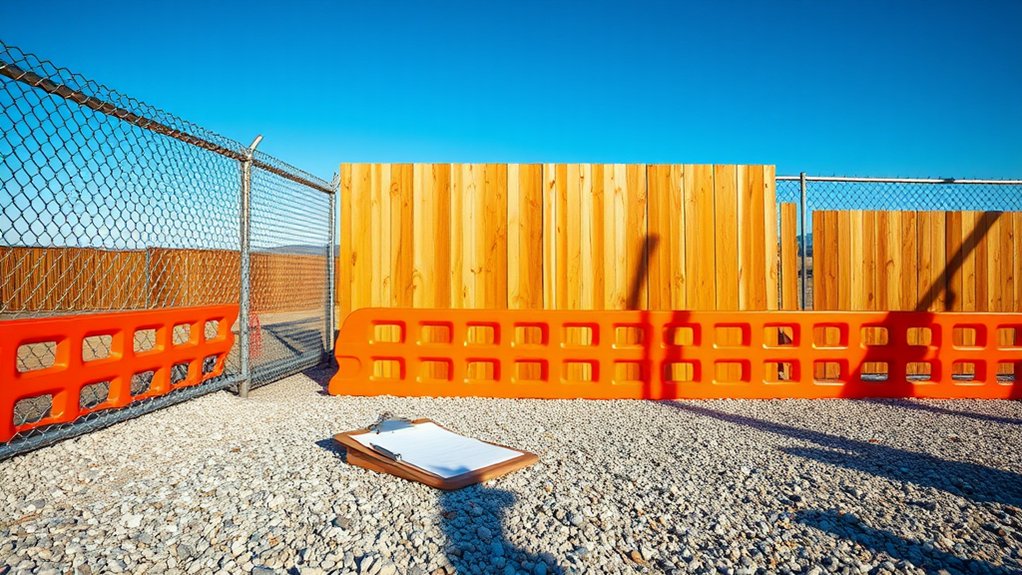
Selecting the right temporary fencing for your construction site can significantly affect your budget and project efficiency. Renting fencing is usually cheaper for short-term projects since it requires less upfront investment and offers flexibility. On the other hand, buying fencing may be more cost-effective for longer projects due to its durability, despite the higher initial cost. For example, chain link and welded wire mesh fences are strong and low-maintenance, which helps lower long-term costs. If you need a quick and budget-friendly option, plastic barriers are lightweight and easy to set up. Additionally, chain link fences are a cost-effective option for boundary fencing, making them a suitable choice for many construction sites.
Key Considerations When Choosing Temporary Fencing
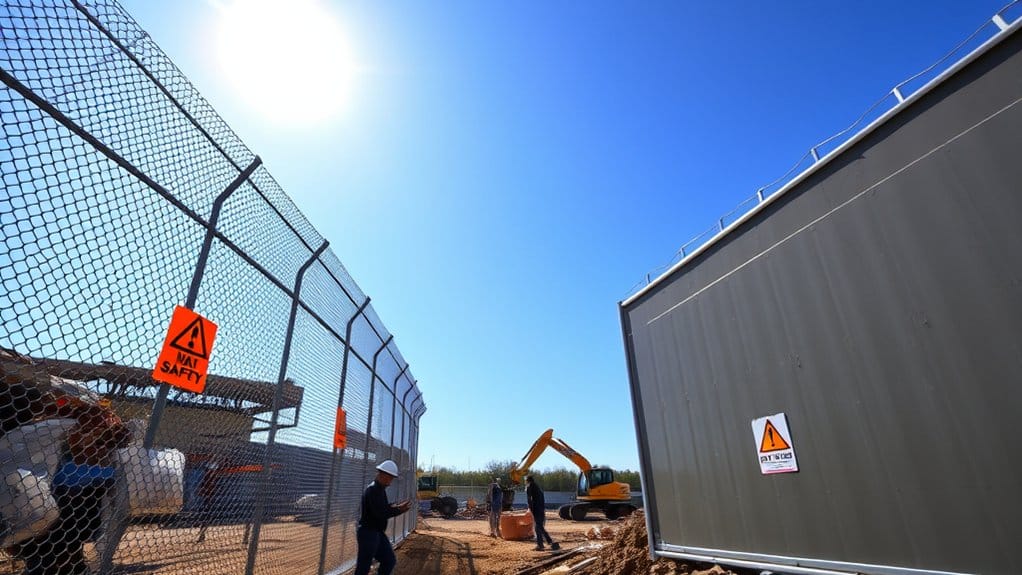
When selecting temporary fencing, first identify its purpose—security, safety, or both.
Next, assess the site conditions such as terrain, weather, and accessibility, as these will impact your choices.
For example, if your site is on uneven ground, you may need more stable fencing options.
Purpose of Fencing
Understanding the purpose of temporary fencing is crucial for safety and compliance at construction sites. Here are three key reasons to consider:
- Safety Compliance: Temporary fencing helps meet OSHA standards, keeping hazardous areas off-limits and reducing injury risks.
- Legal Requirements: Many local regulations require fencing to avoid fines and ensure compliance.
- Visual Deterrent: Fencing acts as a barrier, preventing unauthorized access and raising public awareness about construction activities.
Additionally, a well-maintained fence can improve the appearance of your site while ensuring safety and security.
Site Conditions Consideration
Site conditions can significantly affect the performance of temporary fencing, so it’s important to assess factors like terrain, weather, and space. This ensures you select the right fencing for your needs.
| Factor | Consideration |
|---|---|
| Terrain | Opt for fencing designed for uneven ground. |
| Weather Conditions | Make sure the fencing can handle strong winds and rain. |
| Ground Stability | Ensure proper anchoring for stability. |
| Available Space | Design the layout to fit within space limits. |
Installation and Flexibility of Temporary Fencing Options
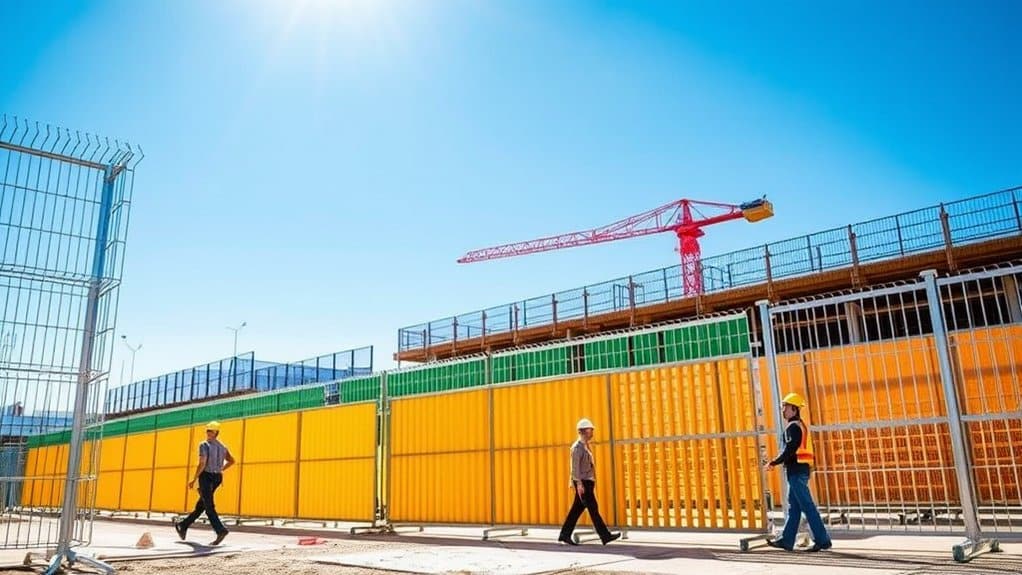
Choosing the right temporary fencing is important for site security, but installation and flexibility matter just as much. Here are some key points to consider:
- Modular Designs: These systems can be easily adjusted to fit your site’s needs, making setup quicker.
- Site Preparation: Before installing, clear away debris and level the ground to ensure stability.
- Gate Configurations: Customize access points for workers while keeping the area secure.
Frequently Asked Questions
How Do I Choose the Right Fencing Type for My Project?
To pick the best fencing type for your project, think about your security needs and the materials you can use. For instance, if you need strong protection, a chain-link or wrought iron fence might be ideal. Consider how durable the materials are, how easy they are to install, and make sure they meet local regulations. This way, you ensure your fence is both effective and functional.
Can Temporary Fencing Be Customized for Specific Site Needs?
Yes, temporary fencing can be customized to fit your specific needs. For instance, you can choose different gate configurations, materials, and added features to enhance security and functionality. Whether you need extra height for privacy or easy access points for vehicles, there are options available to suit your site perfectly.
What Permits Are Required for Installing Temporary Fencing?
Before installing temporary fencing, check your local permit requirements. You may need to submit site plans detailing the materials, height, and intended duration of the fence. This helps you avoid fines and delays. For example, if you’re setting up a fence for a community event, ensure all paperwork is in order to keep the process smooth.
How Long Can Temporary Fencing Typically Be Used?
Temporary fencing usually lasts from a few months to a couple of years, depending on the quality of the materials and environmental conditions. Always check local regulations, as they may set limits on how long you can use it.
Are There Eco-Friendly Options for Temporary Fencing Materials?
Yes, there are eco-friendly temporary fencing options. Consider using reclaimed wood or biodegradable materials like recycled plastics. These choices help reduce waste and support environmental preservation in your construction projects.
Conclusion
Choosing the right temporary fencing for your construction site is crucial. Just like using the right tools, the wrong fence can cause delays and increase costs. A solid fence, whether it’s chain link, steel hoarding, or wire mesh, protects your site and investment. Assess your needs, and you’ll ensure safety and keep your project on schedule.

